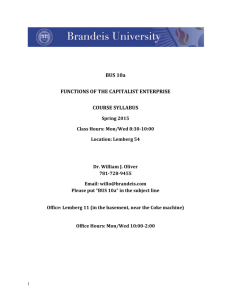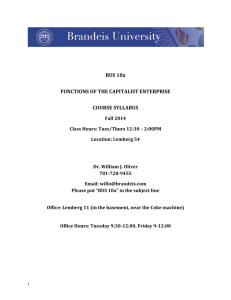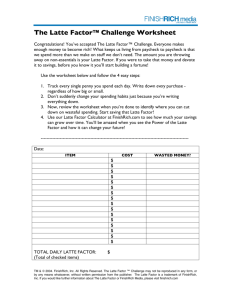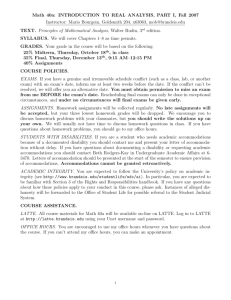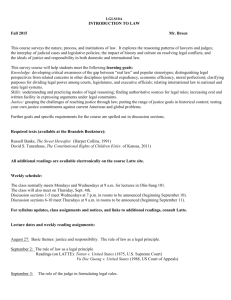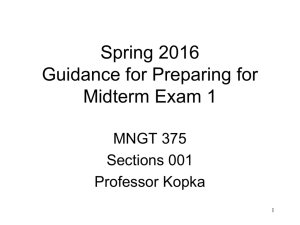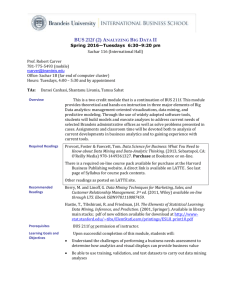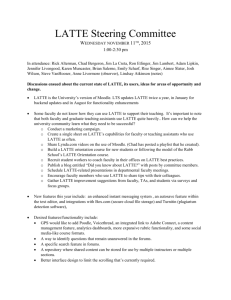course syllabus - Brandeis University
advertisement
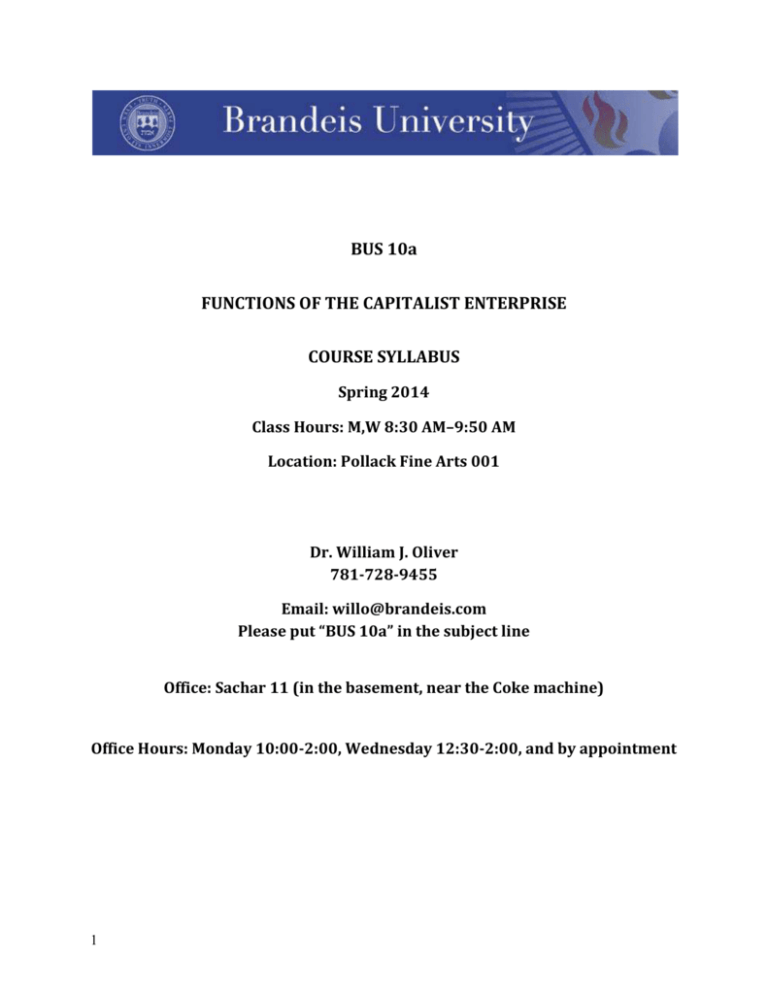
BUS 10a FUNCTIONS OF THE CAPITALIST ENTERPRISE COURSE SYLLABUS Spring 2014 Class Hours: M,W 8:30 AM–9:50 AM Location: Pollack Fine Arts 001 Dr. William J. Oliver 781-728-9455 Email: willo@brandeis.com Please put “BUS 10a” in the subject line Office: Sachar 11 (in the basement, near the Coke machine) Office Hours: Monday 10:00-2:00, Wednesday 12:30-2:00, and by appointment 1 Objectives This course is an integral part of the Business minor and major. It uses case examples and practical concepts to build a framework for addressing key management issues. There are five primary learning outcomes for students: 1. 2. 3. 4. 5. Understand the fundamental concepts and functions in business management Recognize the interrelationships among these functions Learn how to apply the language and tools of the course to a range of business issues Learn how to read, analyze, and discuss business school case studies Develop oral presentation skills for business The first half of the course reviews the key functions of managers through cases and mini-lectures on finance, marketing, operations, organizational behavior, and strategy. The second half applies this knowledge to three broad themes: the unique issues related to entrepreneurship, business in the global economy, and business ethics. This section of BUS 10a is somewhat unique, in that it focuses more on the issues faced by the entrepreneur and the innovator, while the other sections focus on other aspects of business. This is a hard course. It anticipates that you spend 3 hours of study per hour of class time1, a total of 120-140 hours preparing for 26 one and a half hour classes. That includes 2-3 hours reading and preparing cases before each class session. In addition, you will spend 20-30 hours preparing each of two presentations and a paper. If you are not a good reader, or English is not your primary language, you may find that you need additional study time. Core Concepts Upon completing this course, you will demonstrate your newly developed ability to assess businesses using several of the most important analytical tools. These will help you understand articles in the press. They will also help you understand the company you work for after graduation: 1 Finding reliable and meaningful information about a company on line Financial ratio and trend analysis, and Key Performance Indicators – to assess a company’s health Quality management – reducing errors and process delays to improve operational performance Porter’s five forces for assessing strategic position SWOT analysis for summarizing a company's condition and potential Business model as a method of describing a business Product life cycle as a tool to assess a company’s products Disruptive innovation that will undermine current company's strategic position Theory X and Y, Z and resonant leadership, teams, and organization structure as aspects of company culture IT Strategy, or how information changes businesses See discussion at: http://www.academictips.org/acad/timemanagement.html, and at: http://commerce.depaul.edu/undergrad/docs/About/studyhourformula.pdf, 2 Five ethical frameworks for sizing up ethical challenges Personal brand – using the concepts of business to build your own “Me, Inc.” This will help you plan your own future—it will also facilitate assessing career opportunities Prerequisites: ECON 2a; BUS 6a (or BUS 4a), which may be taken concurrently with BUS 10a. I encourage you to take BUS 1B before 10A. Materials Core Readings: The course is built on a core set of readings and cases. Many of these are available through LATTE. You will also purchase a case readings set from HBS Publishing, at the link below. If you have question about purchasing, call 800-810-8858 or 617-783-7700. Link: http://cb.hbsp.harvard.edu/cb/access/14233733 xxxxxxxxxxxx Recommended Text: The text is available on reference in Goldfarb library, and older editions are available on line for less than $10. The text will not specifically be used in lectures or the test. It is a valuable reference extending into many other aspects of the Functions of a Capitalist Enterprise. Text: Ronald J. Ebert and Ricky W. Griffin, Business Essentials, any edition. Please note that other sections of BUS 10a use the 6th edition. Grading Contributions to class discussions and team projects (25%) The course is built around class and team project participation. That is not attendance, but participation. Project participation will be assessed through a one-page self-assessment completed after each team project. There are four levels of class participation: 1. 2. 3. 4. A key promoter of other student’s participation Contributes regularly, but through individual comments—not building a discussion Contributes more than once to every class discussions Attends every class, contributes to some The objective for each student is to move up to a higher level than experienced in previous courses. Mid-way through the term, the professor will meet with each student to assess performance and adjust individual participation objectives. To be effective in class participation requires advance preparation. For each reading: write down 510 insights you got from the article. Also write down 3-5 questions you would ask the author (perhaps things you don’t understand, or even disagree with) if you had the chance. For each case study, spend two to three hours preparing (no, I am not kidding): 3 Keep a notebook of your case preparation notes (this is not handed in) Read the open and closing paragraphs of the case Look at the figures in the back. For each, ask yourself what is the point of the figure Read all the headings in the body of the case Read the first sentence of each paragraph Write down: why are we discussing this case. Some cases specifically ask a question, others are a chance to learn some aspect of business. Part of this step is to assess which of the core concepts apply—and should structure the discussion Read the case (at this point, you will have spent your first hour) Write down: 10 key observations that you think should come up in the discussion of the case. You should write them down so you do not have to remember them during class, or think about how to express them. Write them down Write down: what are 5 key questions on which the case discussion should turn. If the case asks for a decision; what are the key sub-questions. If the case is to learn about a management approach, what is it that makes the approach unique and successful? Do calculations: as you learn the core concepts, apply them to the case. Write down your thoughts, so that you can easily refer to them during the discussion Look outside the case. The Internet can often give you information about what has actually happened to the company since the case was written. This can liven up the discussion I recommend that you get together in a group of 2-3 to discuss the case. A group can meet in person, on the phone, or even simply exchange emails about the case. The group will increase your confidence that you have something valuable to say After each class session, reconsider your participation that day: level 1, 2, 3 or 4? Write that in your notebook. Plan to “take it up a notch” next class session. Midterm exam (25%) This is a written, open-book exam that will be conducted during the normal class period. You will be asked essay questions about the materials covered and issues discussed in class. It will require you to do some calculations as well as assess some companies from the perspective of the approaches you have learned in the course thus far. The midterm will be very challenging. You will complete the exam with your computer and submit it on LATTE at the end of the class period. Five assignments to assess businesses: Tracking a company (5%) Individual assignment. You will choose one of three methods for completing this part of the course. You will write ab out a company each week. See separate instructions on LATTE PowerPoint presentation on “Cafeteria Day” (10%) Group assignment in teams of 5 or 6 students concerning one of the university‘s cafeterias or food stores. See details below. Business attire is required. PowerPoint presentation on globalization (15%) Group assignment in teams of 4 or 5 students. Each presentation (on a theme of your choice) should last 8-10 minutes, plus time for Q+A. The should involve how globalization has affected a company, or how a company has been instrumental in driving globalization. As with any good paper, you start with a theme—what is the topic your paper will explore. The ideal paper spells out a question in the first paragraph. Consider the facts. Select several global perspectives 4 Please submit the topic as indicated on the schedule: who is on your team and what your proposed topic will be; only one submission per team, though! I will let you know the following day if that topic has already been selected by another team. Business attire is required. Essay on the ethical issues surrounding the sub-prime mortgage debacle (5%) Individual assignment. Write two pages double spaced, due at the start of class on Monday, April 23. This is an individual assignment. Final paper analyzing a business problem facing a real company (15%) Group assignment in teams of 3-4 students. The final paper must be done in teams of 3 students. The final paper is an opportunity for teams of 3 students to examine in depth a topic of your choice. The paper must be 10 - 15 double-spaced pages (plus footnotes and references) and cover: Describe the facts around a problem a real company is facing today, Use the core concepts you learned in the course (i.e. the list above) to evaluate the situation, and Offer a clear set of recommendations that are carefully analyzed. NOTE: Teams will reconfigure for each assignment. Grades on written assignments are assigned to all members of the team, though I reserve the right to alter individual grades when it is clear that an individual contributed significantly more or less to the assignment. Submitting Assignments Papers must be submitted as an MSWord document. Presentations must be submitted as a PowerPoint. Files must be readable on the Wintel platform; if you prepare documents on a Mac, you are responsible for submitting them in compliant format (if I cannot read your file, you cannot expect a good grade). Assignments are to be submitted to LATTE by 8:00 AM the day before class. Papers that are submitted late will be graded down one full grade (e.g. from A to B) for each day or portion thereof. Computers in the Classroom Computers are welcome in class, if they are used to support your classroom learning. Some examples of good uses include taking notes, referring to case studies (to avoiding wasting paper), referring to lists, notes or analyses you did in preparation for class. You can also quickly check into something you are hearing in a discussion by searching a topic. On the other hand, email, social media, shopping, checking sports scores are not appropriate uses. If you are found misusing your computer in the classroom, the professor will ask you to leave, and you will lose credit for participating that class session. 5 Seating Please select a seat on the first day of class, and use that seat for each class session. This helps the professor get to know you (i.e. it helps establish your class participation grade). Please bring the name tent that you create the first day. Academic Honesty You are expected to be honest in all of your academic work. Instances of alleged dishonesty will be forwarded to the Office of Campus Life for possible referral to the Student Judicial System. Potential sanctions include failure in the course and suspension from the University. For the University policy, please see section 5 of the Rights and Responsibilities Handbook. Special Accommodation If you are a student with a documented disability on record at Brandeis University and wish to have a reasonable accommodation made for you in this class, please see me immediately. 6 Course Calendar (subject to change) Date Topic 13-Jan Introduction: what is capitalism? Where has it been? Where is it going? Syllabus, Drucker, Theory of Business (ResourcesLATTE) 15-Jan Kellogg‘s 2010 annual report (Resources-LATTE), A Guide to Case Analysis (Resources-LATTE), How to Find Information on a Company (LATTE) 20-Jan 22-Jan Finding reliable and meaningful information about a company on line. SWOT analysis No Class Quality management 27-Jan Four Ps of Marketing Mix 29-Jan Theory X and Y, Z and resonant leadership Taran Swan at Nickelodeon Latin America (A) Economist: Theories X & Y (Key Concepts-LATTE), Resonant Leadership (Key Concepts-LATTE) 3-Feb Porter’s five forces Howard Schultz and Starbucks Coffee 5-Feb Snow day Business Model, Chesbrough (Key Concepts-Key Concepts-LATTE), Business Model Canvas Video (Key Concepts-LATTE) Porter: Five Competitive Forces that Shape Strategy (Key Concepts-LATTE) 10-Feb Student presentations: “Cafeteria Day” 12-Feb Porter’s Five Forces Business Model No Class No Class Financial ratio and trend analysis Comparing companies using ratios 17-Feb 19-Feb 24-Feb 7 Due on LATTE by 8AM day of class Case Benihana of Tokyo Cafeteria Day: team members and venue Reebok International Ltd Advance Readings Quality Management (Key Concepts-LATTE), Business Model (LATTE) Four Ps (Key Concepts-LATTE), 4Ps Video (Key Concepts- LATTE) Cafeteria Day Presentations Crown Cork and Seal in 1989 Ratios practice set Financial Ratios Defined (Key Concepts-LATTE), Kellogg’s annual report (Resources-LATTE)Coca-Cola 2010 annual report (Resources-LATTE) Date Topic 26-Feb Financing the enterprise 3-Mar 5-Mar 10-Mar Midterm Preparation Midterm (in normal class time) “Big data," communications and ERP: IT tools of business strategy 12-Mar 17-Mar 19-Mar 24-Mar Midterm Results Midterm Results Globalization Entrepreneurship 26-Mar Business model 31-Mar Managing Innovation 2-Apr Disruptive innovation 7-Apr Social Entrepreneurship 9-Apr 14-Apr Five ethical frameworks Business Ethics 16-Apr Healthcare innovation 21-Apr Globalization presentations 23-Apr 28-Apr Globalization presentations Course review, personal brand 8 Due on LATTE by 8AM day of class Case Cartwright Lumber Company Advance Readings Ratios practice set Cisco Systems Architecture: ERP and Web-enabled IT Globalization readings (LATTE) Globalization team members and proposed topic Final paper: teams and one-page outline Individual Ethics Paper Li & Fung Facebook Zipcar: Refining the Business Model Kodak and the Digital Revolution (A) Teva Pharmaceutical Industries, Ltd Patrimonio Hoy Parable of the Sadhu Business Ethics – subprime mortgage xxxxxxxxxxxx Bhide, The Questions Every Entrepreneur Must Answer (Resources-LATTE) Amit-Creating Value through Business model Innovation (LATTE) Chesbrough: Business model innovation (LATTE) xxxxxxxxxxxx Pralahad, Fortune at the Bottom of the Pyramid (Resources-LATTE) Ethics readings (Resources-LATTE) Subprime mortgage crisis readings (ResourcesLATTE) Christensen: Will Disruptive Innovations Save Healthcare? (Resources-LATTE) Globalization presentation Final paper Personal Brand (Resources-LATTE) 9
